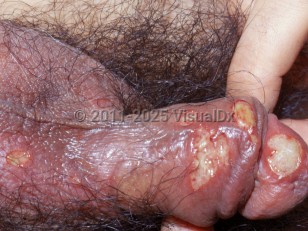Chancroid
See also in: AnogenitalAlerts and Notices
Important News & Links
Synopsis

Chancroid is a sexually transmitted infection (STI) caused by Haemophilus ducreyi, a gram-negative facultative anaerobe.
Chancroid is rare in the United States, and prevalence has been decreasing worldwide. Infection, usually associated with sporadic outbreaks, may still be a cause of genital ulcer in certain regions in Africa and the Caribbean. Cases may be underestimated due to the difficulty in isolating the organism and subsequent underreporting.
Individuals in communities with high rates of commercial sex (sex workers, clients, and their partners) are at higher risk for chancroid. In addition, chancroid increases the risk for transmission of HIV. Similarly, HIV infection increases the risk of chancroid and leads to atypical presentations such as a longer incubation period, multiple ulcers, and extended healing times. Extragenital chancroid is also more common in HIV coinfection.
The period of incubation is 3-7 days. Patients rarely present with prodromal symptoms. The earliest form of presentation is a painful genital papule that becomes an ulcer with a shaggy (ragged) border within a few days. If the lesion is neglected and untreated, it can cause significant tissue destruction.
Chancroid is rare in the United States, and prevalence has been decreasing worldwide. Infection, usually associated with sporadic outbreaks, may still be a cause of genital ulcer in certain regions in Africa and the Caribbean. Cases may be underestimated due to the difficulty in isolating the organism and subsequent underreporting.
Individuals in communities with high rates of commercial sex (sex workers, clients, and their partners) are at higher risk for chancroid. In addition, chancroid increases the risk for transmission of HIV. Similarly, HIV infection increases the risk of chancroid and leads to atypical presentations such as a longer incubation period, multiple ulcers, and extended healing times. Extragenital chancroid is also more common in HIV coinfection.
The period of incubation is 3-7 days. Patients rarely present with prodromal symptoms. The earliest form of presentation is a painful genital papule that becomes an ulcer with a shaggy (ragged) border within a few days. If the lesion is neglected and untreated, it can cause significant tissue destruction.
Codes
ICD10CM:
A57 – Chancroid
SNOMEDCT:
266143009 – Chancroid
A57 – Chancroid
SNOMEDCT:
266143009 – Chancroid
Look For
Subscription Required
Diagnostic Pearls
Subscription Required
Differential Diagnosis & Pitfalls

To perform a comparison, select diagnoses from the classic differential
Subscription Required
Best Tests
Subscription Required
Management Pearls
Subscription Required
Therapy
Subscription Required
References
Subscription Required
Last Reviewed:10/18/2018
Last Updated:07/29/2021
Last Updated:07/29/2021
Chancroid
See also in: Anogenital
